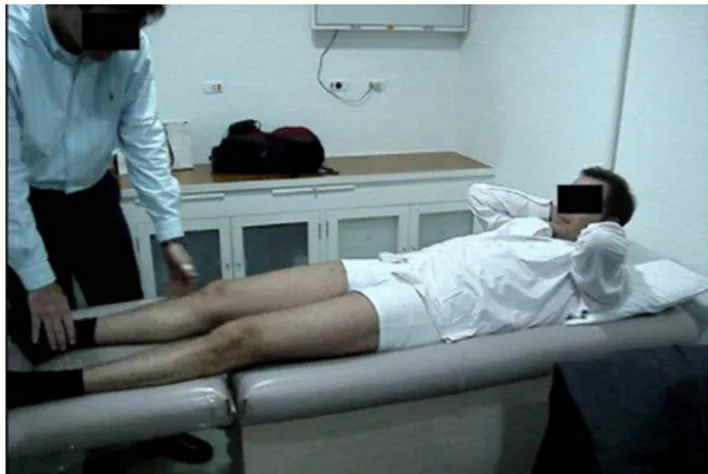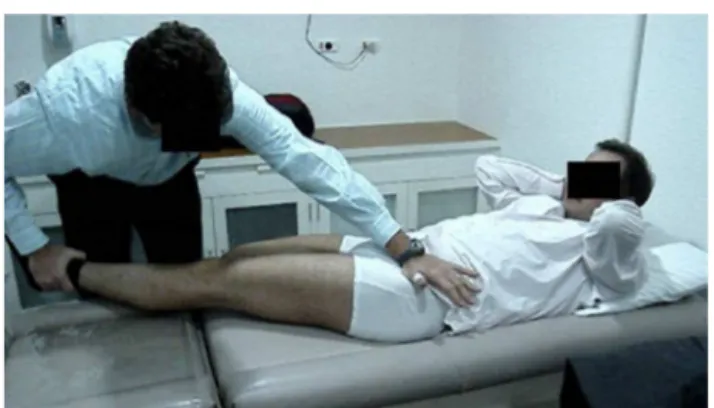rev bras ortop.2014;49(5):532–534
w w w . r b o . o r g . b r
Technical
Note
Proposal
for
a
new
clinical
test
for
diagnosing
lateral
hip
snapping
夽
,
夽夽
Henrique
Antonio
Berwanger
de
Amorim
Cabrita
a,
Henrique
Melo
de
Campos
Gurgel
a,∗,
Ricardo
Marques
b,
Leandro
Emilio
Nascimento
Santos
c,
José
Ricardo
Negreiros
Vicente
a,
Marcos
de
Camargo
Leonhardt
a,
Leandro
Ejnisman
a,
Alberto
Tesconi
Croci
daInstitutodeOrtopediaeTraumatologia,HospitaldasClínicas,FaculdadedeMedicina,UniversidadedeSãoPaulo(USP),SãoPaulo,SP,
Brazil
bInstitutoVita,SãoPaulo,SP,Brazil
cHospitalFelícioRocho,BeloHorizonte,MG,Brazil
dFaculdadedeMedicina,UniversidadedeSãoPaulo(USP),SãoPaulo,SP,Brazil
a
r
t
i
c
l
e
i
n
f
o
Articlehistory:
Received2September2013 Accepted2September2013 Availableonline27August2014
Keywords: Hip Hipinjuries Arthralgia
a
b
s
t
r
a
c
t
Lateralhipsnappingisanosologicalentitythatisoftenunknowntomanyorthopedistsand eventosomehipsurgeryspecialists.Itcomprisespalpableand/oraudiblesnappingonthe lateralfaceofthehipthatissometimespainful,causedbymuscle-tendonfrictiononthe greatertrochanterduringflexionandextensionofthecoxofemoraljoint.Inthefollowing, wedescribeanewtestfordiagnosinglateralhipsnapping,whichiseminentlyclinical.
©2014SociedadeBrasileiradeOrtopediaeTraumatologia.PublishedbyElsevierEditora Ltda.Allrightsreserved.
Proposta
de
um
novo
teste
clínico
para
o
diagnóstico
do
ressalto
lateral
do
quadril
Palavras-chave: Quadril
Lesõesdoquadril Artralgia
r
e
s
u
m
o
Oressaltolateraldoquadriléumaentidadenosológicamuitasvezesdesconhecidapela maioriadosortopedistaseatémesmoporalgunsespecialistasemcirurgiadoquadril. Trata-sedapresenc¸adeumestalidopalpávele/ouaudívelnafacelateraldoquadril,porvezes doloroso,causadopeloatritomusculotendíneosobreograndetrocanterduranteaflexão eaextensãodaarticulac¸ãocoxofemoral.Descreveremosaseguir umnovotesteparao diagnósticodoressaltolateraldoquadril,queéeminentementeclínico.
©2014SociedadeBrasileiradeOrtopediaeTraumatologia.PublicadoporElsevierEditora Ltda.Todososdireitosreservados.
夽
Pleasecitethisarticleas:deAmorimCabritaHAB,deCamposGurgelHM,MarquesR,SantosLEN,VicenteJRN,deCamargoLeonhardt Metal.Propostadeumnovotesteclínicoparaodiagnósticodoressaltolateraldoquadril.RevBrasOrtop.2014;49(5):532–4.
夽夽
WorkdevelopedintheDepartmentofOrthopedicsandTraumatology,HospitaldasClínicas,MedicalSchool,UniversidadedeSão PauloandattheVitaInstitute.
∗ Correspondingauthor.
E-mail:drgurgel@usp.br(H.M.d.C.Gurgel). http://dx.doi.org/10.1016/j.rboe.2014.08.004
rev bras ortop.2014;49(5):532–534
533
Introduction
Itmaybedifficulttoevaluatepatientswithhippaingiventhat thereare vast numbers ofdifferential diagnoses,including intra-articularandextra-articularpathologicalconditionsand painrelatingtopelvicandvertebralpathologicalconditions.
Advancesinimagingexaminations, particularregarding magneticresonanceimaging,andknowledgecomingfromthe evolutionofsurgicalproceduressuchasarthroscopyhaveled togreater comprehensionofthefunctional anatomyofthe hip,whichincludesdiseasesofsofttissuessuchasmuscles andtendons.1
Thegreatertrochantericpainsyndromewasdefined orig-inallyas“painfulpalpationabovethegreatertrochanter”and itincludestrochantericbursitis,tendinopathyofthegluteus mediusand minimus muscles and lateral hip snapping. It hasgreater prevalenceamongwomen thanamongmen.1,2 It isrelatively common and affects 10–25% ofthe general population,1 but only a small percentage presents lateral snapping.
Lateralhipsnapping,alsoknownassnappingorclacking ofthe iliotibialband (ITB), occursthroughfriction between the posterior edge of the ITB or anterior edge of the glu-teus maximus muscle and the lateral face of the greater trochanter duringhip movements, particularly flexion and extension.1,3–5 When thehip isextended,the ITBis poste-riortothegreatertrochanter.Asthehipisthenflexed,the ITBpassesbythegreatertrochantertoreachamoreanterior position.Althoughthispassageisphysiologicalandbenign, snappingmayoccurincasesoflateraltensionandthis some-timesbecomesaninflammatoryandpainfulconditionthat irradiates tothe lateral face of the thigh or tothe ipsilat-eralglutealregion.6Patientswithsymptomaticsnappingare generallyyoungandphysicallyactive.1Thesnappingmaybe voluntaryorinvoluntary7andpalpableand/oraudible.8
Becauseofthefewstudiesthathavebeenpublishedonthis topic,thediagnosisofsnappingisoftennotmadeand ade-quatetreatmentisimpaired.History-takinggenerallyshows thatthepatientsareactive,withanontraumaticlong-lasting conditionthatshowsprogressivesymptomsof“discomfort” aroundthegreatertrochanter.Underphysicalexamination, patientsmaybeabletoreproducethesnappingunaided,or theorthopedistmayfinditthroughhipextensionand flex-ionmaneuvers,withthepatientinhorizontalorlateraldorsal decubitus.TheObertest maybepositiveand indicate ten-sionintheITB,andTrendelenburggaitmaybefound,thus indicatinggluteallesions.4
Snapping needstobedifferentiated from intra-articular causesofclacking ofthehip, suchasfreebodies, synovial osteochondromatosisandlesionsoftheacetabularlabrum.9,10 Simple radiographs of the coxofemoral joint are generally normalandthisresulthelpstoruleoutfreebodies. Examina-tionslikestaticultrasoundandmagneticresonanceimaging mayshow localinflammatoryprocesses, and these exami-nationshelptocorroboratethediagnosisoflateralsnapping and are also important for discarding other likely causes of clacking hips. Dynamic ultrasound is the best method for making imaging diagnoses of snapping, although it is examiner-dependent.11
Thetreatmentforpainfulsnappingcanbeconservative, throughchangingtheactivitiesthatcauseit,administrationof oralanalgesicsandanti-inflammatorydrugs,stretching exer-cisesfortheiliotibialtractand,ifnecessary,localinfiltration withcorticoidsandanesthetic,whichdiminishesthe inflam-mationoftheiliotibialtractandthehipbursas.
Inaminorityofthesecases,ifconservativetreatmentfails, surgery becomes necessary.1 This generally involves zeta-plastywithstretchingorresectionofpartoftheITB,andit can be done bymeans of open techniques8 or endoscopic techniques.3,4
Althoughthemechanismthatcausessnappinghasbeen welldescribedintheliterature,noclinicaltesthasyetbeen describedfordiagnosisthis,tothebestofourknowledge.
Theaimofthisstudywastodescribeasimpleclinicaltest withthecapacitytoidentifylateralsnappingofthehip.
Description
of
the
clinical
test
Thepatientshouldbepositionedinhorizontaldorsal decu-bitus on an examination bed, with the lower limbs fully extended. Theexaminer stands contralaterallytothe limb that is to be tested, in order to carry out the maneuvers (Fig.1).
Fig.1–Examinerpositionedonthesidecontralateraltothe limbthatistobeexamined.
534
rev bras ortop.2014;49(5):532–534Fig.3–Internalrotationofthehipwiththehipflexedat 15◦andadductedat45◦.Atthismoment,thesnappingcan
beseenwhenthetestispositive.
Fig.4–Externalrotationofthehipwiththehipflexedat 15◦andadductedat45◦.Atthismoment,thesnappingcan
beseenwhenthetestispositive.
Thelimbthatisnotgoingtobeexaminedisthenmoved offthebedandislefthanging,withthekneeflexedat90◦.The
lowerlimbthatistobeexaminedshouldbepositionedwith thekneeextendedandwiththehipflexedat15◦andadducted
at45◦(Figs.2and3).
Theexaminer placesweight onthe anterosuperior iliac spinewithonehandandthusstabilizesthepelvis.Withthe other,heholdsthelowerlimbunderexaminationbytheankle and makesinternal and external hip rotation movements (Figs.3and4).
Whenthelimbispositiveforsnapping,thisisnotedonthe lateralfaceofthehip.Thesnappingisoftenvisible,palpable andevenaudible,anditmayormaynotbepainful.
Final
remarks
Althoughlateralsnappingofthehipisrareandgenerally pain-less,itshouldformpartofthedifferentialdiagnosisforpainful hipsyndrome.
Webelievethatthetestdescribedabovemayhelp orthope-diststorecognizelateralsnappingofthehip,althoughfurther studieswouldbenecessaryinordertoconfirmitsvalidityand reproducibility.
Conflicts
of
interest
Theauthorsdeclarenoconflictsofinterest.
r
e
f
e
r
e
n
c
e
s
1.StraussEJ,NhoSJ,KellyBT.Greatertrochantericpain syndrome.SportsMedArthrosc.2010;18(2):
113–9.
2.VoosJE,RudzkiJR,ShindleMK,MartinH,KellyBT. Arthroscopicanatomyandsurgicaltechniquesfor peritrochantericspacedisordersinthehip.Arthroscopy. 2007;23(11):1246,e1-5.
3.IlizaliturriVMJr,Martinez-EscalanteFA,ChaidezPA, Camacho-GalindoJ.Endoscopiciliotibialbandreleasefor externalsnappinghipsyndrome.Arthroscopy.
2006;22(5):505–10.
4.IlizaliturriVMJr,Camacho-GalindoJ.Endoscopictreatmentof snappinghips,iliotibialband,andiliopsoastendon.Sports MedArthrosc.2010;18(2):120–7.
5.AllenWC,CopeR.CoxaSaltans:thesnappinghiprevisited. JAmAcadOrthopSurg.1995;3(5):303–8.
6.ZoltanDJ,ClancyWGJr,KeeneJS.Anewoperativeapproach tosnappinghipandrefractorytrochantericbursitisin athletes.AmJSportsMed.1986;14(3):201–4.
7.JustisEJ.Snappinghip.In:Campbell’soperativeorthopaedics. St.Louis:CVMosby;1980.p.1403.
8.YoonTR,ParkKS,DiwanjiSR,SeoCY,SeonJK.Clinicalresults ofmultiplefibrousbandreleasefortheexternalsnapping hip.JOrthopSci.2009;14(4):405–9.
9.WhiteRA,HughesMS,BurdT,HamannJ,AllenWC.Anew operativeapproachinthecorrectionofexternalcoxasaltans: thesnappinghip.AmJSportsMed.2004;32(6):1504–8. 10.ProvencherMT,HofmeisterEP,MuldoonMP.Thesurgical
treatmentofexternalcoxasaltans(thesnappinghip)by Z-plastyoftheiliotibialband.AmJSportsMed. 2004;32(2):470–6.

